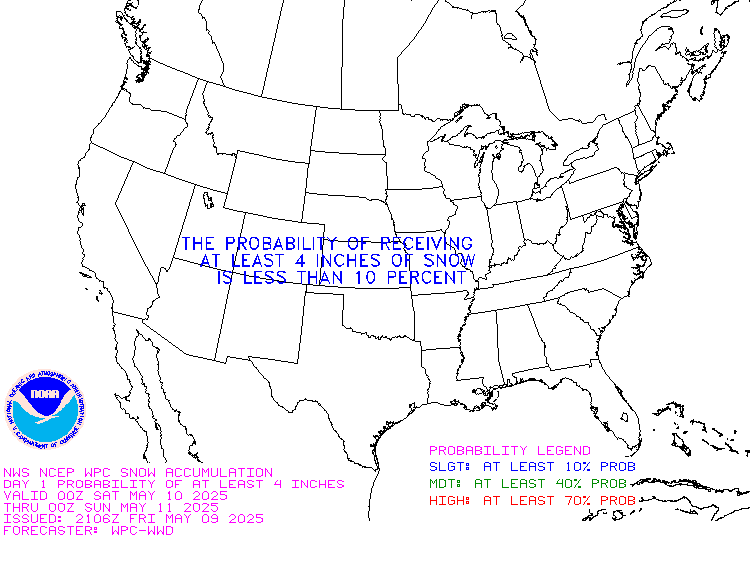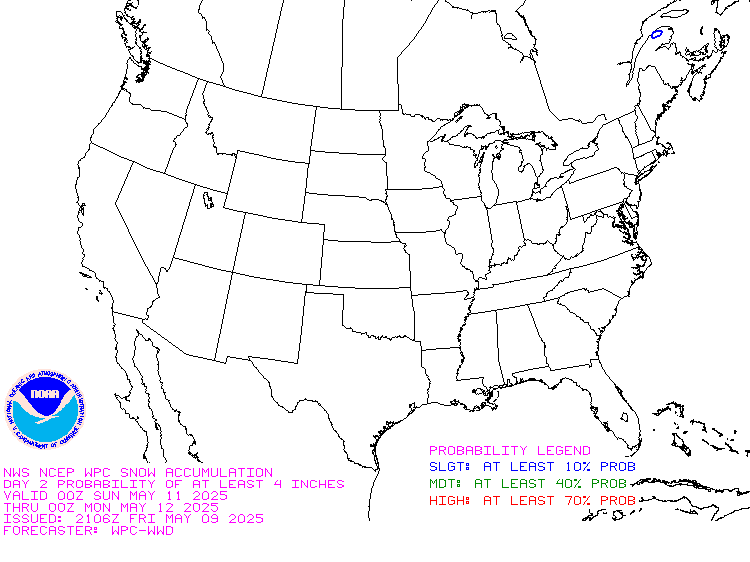It is difficult to find a more comprehensive Weather Outlook anywhere else with the ability to get a local 10-day Forecast also.
This article focuses on what we are paying attention to in the next 48 to 72 hours. The article also includes weather maps for longer-term U.S. outlooks and a six-day World weather outlook which can be very useful for travelers.
First the highlights from the NWS.
Short Range Forecast Discussion
NWS Weather Prediction Center College Park MD
Sat Feb 03 2024
Valid 12Z Sat Feb 03 2024 – 12Z Mon Feb 05 2024…Showers and thunderstorms Saturday for the Lower Mississippi Valley,
with the risk of scattered flash flooding along the Gulf Coast……Moderate to heavy snowfall Saturday for portions of the
Northern/Central Rockies and eastern Great Basin……Strong Atmospheric River to bring a considerable risk for flash
flooding and very heavy snow to California beginning Saturday night……Mild, well above average temperatures will persist across central
portions of the country this weekend…
Looking out a bit farther and focusing on the more series events:
Above is a 72 hour animation of the forecast.
Then, looking at the world and of course, the U.S. shows here also. Today we are looking at precipitation.
Please click on “Read More” below to access the full report issued today.
| Notices: The article on the Seasonal Outlook can be accessed HERE. What would you like to learn about? Please provide that to me via the comment section at the end of the article. |
Now more detail on the 48-Hour Forecast (It is a 48 to 72 Hour Forecast actually)
Daily weather maps. The Day 1 map updates twice a day and the Day 2 and 3 maps update only once a day. These maps update automatically. But if that does not happen, you can get updates by clicking HERE
TODAY (or late in the day the evening/overnight map will appear) (Key to surface fronts shown on maps and you will then also be able to insert a city name or zip code and get a local NWS forecast).
TOMORROW
NEXT DAY
This animation shows how things may play out over the next 60 hours. To update click here.
The NWS Climate Prediction Center’s: Watches, Warnings, and Advisories plus other information can be found HERE. We post at least one of those updates daily, sometimes both. The Highlights are shown in the lede paragraph of this article.
ATMOSPHERIC RIVERS
This tells us what is approaching the West Coast. Click HERE to update If I have not gotten around to doing the update. Here is some useful information about Atmospheric Rivers.
Continuation of the NWS Short Range Forecast. It is updated by NWS twice a day and these updates can be found here
Widespread, organized showers and thunderstorms will continue eastward
from the Southern Plains into the Lower Mississippi Valley Saturday ahead
of a deep upper-level trough/closed low and accompanying surface frontal
system. Strong southerly flow ahead of the front will funnel warm, moist
Gulf air northward helping to fuel some heavier downpours, particularly
for locations along the Gulf Coast. A Slight Risk of Excessive Rainfall
(level 2/4) has been outlined for this region as the heavy downpours, and
the threat for some repeated/training storms, will bring the risk of some
scattered instances of flash flooding. Storm chances will shift into the
Southeast and Florida Sunday with a continued chance for moderate to
locally heavy rainfall, and the threat of an isolated instance or two of
flash flooding.To the West, moderate to heavy snow showers will continue over portions of
the Northern/Central Rockies and eastern Great Basin Saturday as moisture
wraps northwestward around the system over the Plains and the accompanying
upper-level trough lingers over the region. Many of the higher elevations
of the regional mountain ranges will see totals between 5-10″. Some
moderate rain/snow showers will also be possible for the adjacent High
Plains, with the chance for accumulating snowfall increasing for areas
immediately along the Front Range from southern Wyoming southward into
Colorado. The snow should begin to taper off from south to north overnight
Saturday into the early morning hours Sunday, lingering longest for the
Northern Rockies where a slow moving front pushing into the region will
keep at least light snow chances up into the day Sunday.Attention then turns to California as a strong Atmospheric River will
bring the threat for considerable flash flooding along the coast and very
heavy, mountain snow in the Sierra. Rainfall is expected to begin as early
as late Saturday night for central portions of coastal California where a
few inches of rain by early Sunday morning may lead lead to some initial
instances of flooding, and a Slight Risk of Excessive Rainfall is now in
effect. The impacts will ramp up quickly during the day Sunday as the deep
Pacific moisture associated with the system overspreads the region. The
combination of favorable onshore/upslope flow along the coastal mountain
ranges; warm, moist air keeping snow levels high; and repeated rounds of
storms will lead to the threat of rainfall totals of 5″+ and rainfall
rates of 1″ per hour. A Moderate Risk of Excessive Rainfall (level 3/4) is
in effect for coastal portions of central and southern California as these
heavy rain totals will bring a considerable risk for flash and urban
flooding as well as the threat for debris flows and mudslides. A Slight
Risk is also in effect inland for portions of central California,
especially along the Sierra where the higher snow levels will increase the
threat for flooding for favorable upslope areas. For the higher elevations
of the Sierra above 5000-6000 feet, very heavy, disruptive snowfall of
several feet is forecast. In addition to the heavy rain and snow, very
strong, gusty winds and damaging high surf are also expected. All
associated impacts will continue into Monday/Tuesday beyond the current
forecast period.Meanwhile, central portions of the country will have an amplified
upper-level ridge in place that will maintain well above average, mild
Winter temperatures for the Northern/Central Plains and the Midwest this
weekend. Daily maximums will be in the 40s for the Northern Plains and the
Great Lakes and the 50s from the Central Plains east through the Middle
Mississippi and Ohio Valleys. While not quite as anomalous, highs
elsewhere in the central/eastern U.S. will still be at or above average,
with 30s and 40s for the Northeast, 50s for the Carolinas, and 60s in the
Southeast and Southern Plains. The storm system and precipitation moving
into the Southeast will bring some cooler temperatures Sunday, dropping
highs into the 40s and 50s. Temperatures will remain on the cooler side of
average across much of the West given upper-level troughing, cloud cover,
and precipitation, with highs mainly in the 40s for the Great Basin, 50s
for the Pacific Northwest and northern California, and 60s for the Desert
Southwest and southern California.
Learn about wave patterns HERE.
Below is the current five-day cumulative forecast of precipitation (Updates can be found HERE)
Ski SnowReports
New Feature – Ski Reports. It is difficult to find reports that auto-update on-screen (and they are very long) but these links will get you to them – If you have additional suggestions make them in the comments section after every Econcurrents Article and we may add those links. We will try to not have too much overlap as that can add to the confusion.
Snow Forecasts. And remember this shows natural snow. Ski resorts also make their own snow.
Day 1

Day 2

Additional snow information can be found here, here, here, and here. The second link provides animations.
Now we look at Intermediate-Term “Outlook” maps for three time periods. Days 6 – 10, Days 8 – 14, and Weeks 3 and 4. An outlook differs from a forecast based on how NOAA uses these terms in that an “outlook” presents information as deviation from normal and the likelihood of these deviations.
Below are the links to obtain updates and additional information. They are particularly useful if you happen to be reading this article significantly later than when it was published. I always try to provide readers with the source of the information in my articles.
| Days 6 – 10 (shown in Row 1) | Days 8 – 14 (Shown in Row 2) | Weeks 3 and 4 (Shown in Row 3 but updates only on Fridays) |
| https://www.cpc.ncep.noaa. gov/products/predictions/610day/ | https://www.cpc.ncep .noaa.gov/products/predictions/814day/ | https://www.cpc.ncep.noaa.gov/products/predictions/WK34/ |
Showing the actual maps. They should now update automatically. The Week 3 – 4 Outlook only updates on Fridays. So below is what I call the Intermediate-term outlook. On Fridays, it extends out 28 Days. That declines day by day so on Thursday it only looks out 22 days until the next day when the Week 3 – 4 Outlook is updated and this extends the outlook by one additional week.
| 6–
10
|
|
|
| 8–
14 |
|
|
| 3–
4 |
|
|
HAZARDS OUTLOOKS
Click here for the latest complete Day 3 -7 Hazards forecast which updates only on weekdays. Once a week probably Monday or Tuesday I will update the images. I provided the link for readers to get daily updates on weekdays. Use your own judgment to decide if you need to update these images. I update almost all the images Friday Night for the weekend edition of this Weather Report. So normally readers do not need to update these images but if the weather is changing quickly you may want to.
Temperature month to date can be found at https://hprcc.unl.edu/products/maps/acis/MonthTDeptUS.png
Precipitation month to date can be found at https://hprcc.unl.edu/products/maps/acis /MonthPNormUS.png
World Forecast [that website is has been intermittant so be patient]
Below are the Day 1 -3 and 4-6 forecasts for temperature and precipitation. Updates and much additional information can be obtained HERE
World Temperature Anomalies
World Accumulated Precipitation
This information is provided by the University of Maine. They draw upon many different sources. There is a lot of information available at the link provided. I have just provided two useful forecasts. There are probably over a hundred different forecasts available from this source.
Worldwide Tropical Forecast (This is a NOAA Product)
This graphic updates on Tuesdays) If it has not been updated, you can get the update by clicking here Readers will only have to do that if they are reading this article much later than the date of it being published.
Information on Tropical Storms can be found HERE. Western Pacific information can be found HERE.
–
| I hope you found this article interesting and useful. |
–
